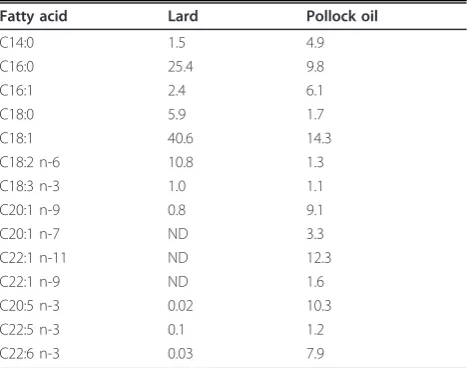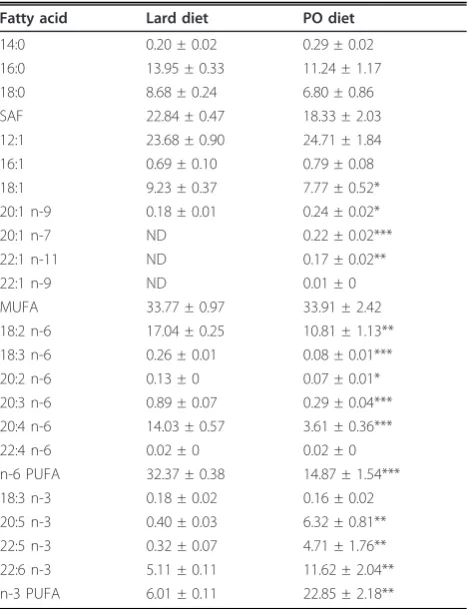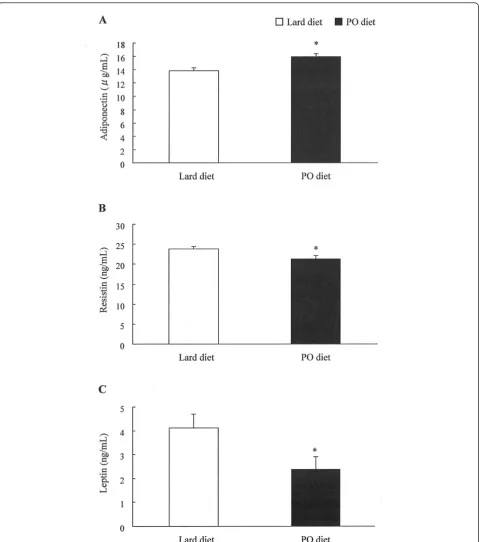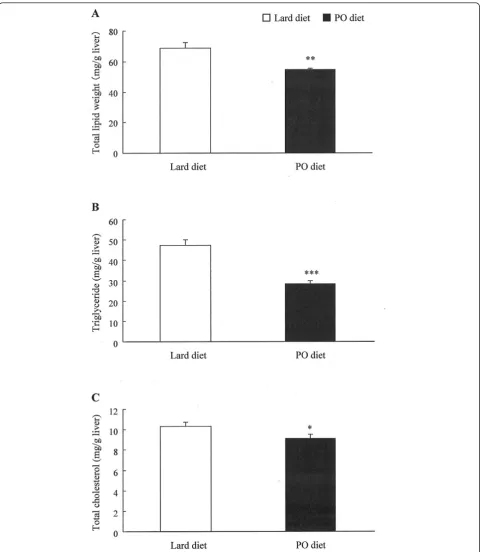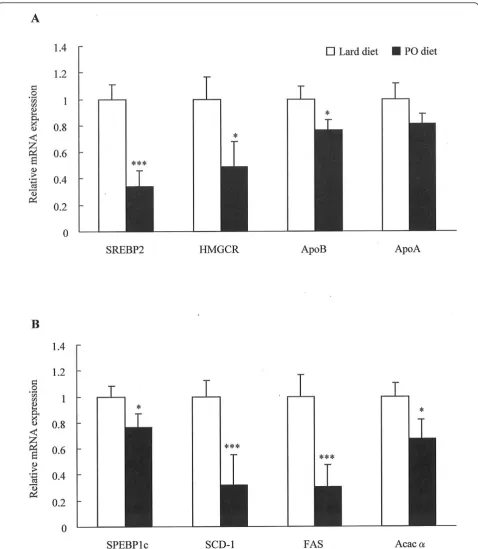R E S E A R C H
Open Access
Pollock oil supplementation modulates
hyperlipidemia and ameliorates hepatic steatosis
in mice fed a high-fat diet
Zhi-Hong Yang
*, Hiroko Miyahara, Jiro Takeo, Akimasa Hatanaka and Masashi Katayama
Abstract
Background:Hyperlipidemia associated with obesity is closely related to the development of atherosclerosis. Both n-3 polyunsaturated fatty acids (PUFAs) and long-chain monounsaturated fatty acids (MUFAs; i.e., C20:1 and C22:1 isomers) supplementation modulate risk factors for metabolic syndrome via multiple mechanisms, including the restoration of impaired lipid metabolism. We therefore examined the effects of pollock oil, which contains a considerable amount of n-3 PUFAs as well as long-chain MUFAs, on plasma hyperlipidemia and hepatic steatosis in diet-induced obese mice.
Methods:Male C57BL/6J mice (24-26 g) were divided into two groups (n = 10/group) and were fed a high-fat diet containing 32% lard (control group) or 17% lard plus 15% pollock oil (experimental group) for 6 weeks. For both groups, fat comprised 60% of the total caloric intake.
Results:Although body and liver masses for the two groups did not differ significantly, hepatic lipids
concentrations (triglycerides and total cholesterols) were lower (P< 0.05) after pollock oil ingestion. After 2 weeks on the specified diets, plasma lipid levels (total cholesterol, LDL cholesterol, and triglycerides) significantly decreased (P< 0.05) in the experimental group compared with the control group, although plasma HDL cholesterol levels did not differ. At the end of 6 weeks, plasma adiponectin levels increased (P< 0.05), whereas plasma resistin and leptin levels decreased (P< 0.05) in the experimental mice. Increased levels of long-chain MUFAs and n-3 PUFAs in plasma, liver and adipose tissue by ingesting pollock oil were possibly correlated to these favorable changes. Expression of hepatic genes involved in cholesterol metabolism (SREBP2, HMGCR, andApoB) and lipogenesis (SREPB1c,SCD-1, FAS, andAcaca) was suppressed in the experimental group, and may have favorably affected hyperlipidemia and hepatic steatosis induced by the high-fat diet.
Conclusions:We demonstrated that pollock oil supplementation effectively improved hyperlipidemia, attenuated hepatic steatosis, and downregulated the express of hepatic genes involved in cholesterol and lipid metabolism in mice with diet-induced obesity.
Keywords:Pollock oil, n-3 PUFA, MUFA, hyperlipidemia, hepatic steatosis, adipokines
Background
Hyperlipidemia, a medical condition characterized by increased blood levels of lipids including cholesterol and triglycerides, is a critical component of metabolism syn-drome as well as a possible predisposing factor for atherosclerosis, a leading cause of death worldwide [1,2]. Lipids that accumulate in the arterial wall as a
consequence of hyperlipidemia are oxidized and attract inflammatory monocytes, which differentiate into macrophages that take up the oxidized lipid. Oxidation of low-density lipoproteins (LDLs) in the arterial wall is a major and physiologically relevant mechanism for the pathogenesis of atherosclerosis, and the presence of lipid-loaded macrophage foam cells in the artery intima is a predictor for the development of atherosclerotic lesions. A close relationship exists between dietary fats and dyslipidemia-related events [3]. Although an
* Correspondence: yangzh@nissui.co.jp
Central Research Laboratory, Tokyo Innovation Center, Nippon Suisan Kaisha, Ltd., 32-3 Nanakuni 1 Chome Hachioji, Tokyo 192-0991, Japan
increased intake of saturated fatty acids is pathogenic for coronary heart disease, numerous studies have demon-strated a protective effect of n-3 polyunsaturated fatty acids (PUFAs) through a variety of mechanisms, includ-ing reduction of triglycerides and very-low-density lipo-proteins [4]. In addition, we have shown that marine-derived long-chain monounsaturated fatty acids (MUFAs) (i.e., C20:1 and C22:1 isomers) modulate metabolic syndrome by restoring impaired glucose and lipid metabolism [5]. Therefore, fish oils that are rich in both n-3 PUFAs and long-chain MUFAs may help alle-viate hypercholesterolemia and hypertriacylglyceridemia.
Alaska pollock (Theragra chalcogramma) is a North
Pacific species of the cod family, Gadidae. Pollock oil contains considerable amounts of n-3 PUFAs and long-chain MUFAs [6]. The Alaska pollock fishing industry is the largest in the United States and one of the largest in the world. In recent years, pollock fishing has accounted for ~30% of all U.S. seafood landings by mass [7]. Although pollock oil is used in both the food and feed industries [8], little is known about the relationship between dietary pollock oil and hyperlipidemia. Given the health benefits of n-3 PUFAs and long-chain MUFAs, we examined the effect of dietary pollock oil on hyperli-pidemia in mice with diet-induced dyslihyperli-pidemia.
Methods
Measurement of fatty acid composition of dietary oils
Cameria lard was purchased from Romi Smilfood B. V. (Heerenveen, Netherlands). Pollock oil was obtained from Nippon Suisan Kaisha, Ltd. (Tokyo, Japan) and refined with silica gel and activated clays and then steam-distillation deodorized. All standard and extracted lipids were stored at -20°C until used. Fatty acid compo-sitions of the dietary fats (Table 1) were determined after methylation of samples with 14% (w/v) boron tri-fluoride/methanol (Sigma Chemical Co., St. Louis, USA.) at 80°C for 30 min. The resulting fatty acid methyl esters were quantified by gas chromatography using an Agilent 6890N Network Gas Chromatograph System (Agilent Technologies Japan, Ltd., Tokyo, Japan) equipped with a split injector, FID detector, and fused silica capillary column (DB-WAX, 30 m × 0.25 mm I.D. × 0.25 μm film thickness, J & W Scientific, Agilent Technologies). Methyl esters were identified by compari-son of retention times to those of fatty acid methyl ester standards (Nu-Chek Prep, Inc., Elysian, MN, USA). Pol-lock oil contains considerable levels of long-chain MUFAs and n-3 PUFAs (C20:1 as well as C22:1 isomers and n-3 PUFAs combined: ~ 45%).
Animals and diets
The Institutional Animal Care and Use Committee at Nihon Bioresearch Inc. (Gifu, Japan) approved this
study. Male C57BL/6J mice (5 weeks old) were obtained from Charles River Laboratories Japan Inc. (Yokohama, Japan) and housed at Nihon Bioresearch at 23 ± 1°C under a 12/12 h light-dark cycle. The animals were pro-vided free access to water and standard mouse chow CRF-1 (Oriental Yeast Co. Ltd., Tokyo, Japan) for a 1-week acclimatization period.
After acclimatization, mice were randomly assigned to one of two groups for the 6-week feeding experiment. The control group (n = 10) was fed a high-fat diet containing 32% lard (D12492 Rodent Diet with 60 kcal% Fat; Research Diets, Inc., NJ, USA) and the experimental group was fed a diet supplemented with pollock oil (17% lard plus 15% pol-lock oil). To control for total fat intake, the total fat content in both diets corresponded to 60% of the caloric intake. The compositions of the diets are listed in Table 2. Body mass and food intake were monitored throughout the study. At the end of the intervention period, mice were
Table 1 Fatty acid composition of dietary fats (%)
Fatty acid Lard Pollock oil
C14:0 1.5 4.9
C16:0 25.4 9.8
C16:1 2.4 6.1
C18:0 5.9 1.7
C18:1 40.6 14.3
C18:2 n-6 10.8 1.3
C18:3 n-3 1.0 1.1
C20:1 n-9 0.8 9.1
C20:1 n-7 ND 3.3
C22:1 n-11 ND 12.3
C22:1 n-9 ND 1.6
C20:5 n-3 0.02 10.3
C22:5 n-3 0.1 1.2
C22:6 n-3 0.03 7.9
Values correspond to mean of three separate samples processed independently.
ND: Not detected.
Table 2 Diet compositions
Ingredient Lard diet (g/100 g diet) PO diet (g/100 g diet)
Casein 25.8 25.8
l-Cysteine 0.4 0.4
Maltodextrin 10 16.2 16.2
Sucrose 8.9 8.9
Cellulose 6.5 6.5
Mineral mixture 1.3 1.3
Vitamin mixture 1.3 1.3
Choline bitartrate 0.3 0.3
Soybean oil 3.2 3.2
Lard 32 17
Pollock oil – 15
anesthetized with 4% sodium pentobarbital (Dainippon Sumitomo Pharma, Osaka, Japan), and blood was collected by abdominal vein puncture. Plasma was obtained by cen-trifugation at 1000 g for 15 min and stored at -80°C until analyses. Vital organs were removed and weighed after a short wash in cold phosphate-buffered saline, pH 7.4. Mesenteric white adipose tissue (WAT) and Livers were kept at -80°C for the further lipid extraction and quantita-tive polymerase chain reaction (QPCR) analysis.
Lipid extraction and fatty acid analysis
The fatty acid compositions of plasma, liver and WAT in the C57BL/6J mice were determined as described before [5]. Lipids were extracted by homogenizing the tissue samples in a methanol/hexane solution (4:1 v/v)
added with butylated hydroxytoluene (BHT, 50μg/mL)
as an antioxidant. The samples were methylated with acetyl chloride, and the fatty acid methyl esters were separated and quantified by gas chromatography. Identi-fication of the methyl esters were made by comparison of retention times of standard fatty acids.
Determination of plasma lipid levels
Blood samples were taken from the retro-orbital venous plexus of each mouse at the end of weeks 0, 2, 4, and 6. Plasma concentrations of triglyceride (TG), total choles-terol (TC), and high-density lipoprotein (HDL) cholescholes-terol were measured using Triglycerol Test, Cholesterol E-Test, and HDL-cholesterol E-Test kits (Wako Pure Che-mical Industries, Ltd., Osaka, Japan), respectively. The concentration of LDL cholesterol was calculated as [LDL cholesterol] = [TC] - [HDL cholesterol] - [TG] × 0.2.
Determination of plasma adipokine levels
Plasma concentrations of adiponectin, resistin, and lep-tin were determined at the end of the 6-week period using the Mouse Adiponectin ELISA kit (Otsuka Phar-maceutical Co., Ltd., Tokyo, Japan), Mouse Resistin ELISA kit (Shibayagi Co. Ltd., Gunma, Japan), and Mouse Leptin ELISA kit (Morinaga Institute of Biologi-cal Science, Inc., Yokohama, Japan), respectively.
Determination of hepatic lipid levels
Total hepatic lipids were extracted from liver samples as described [9]. Extracted lipids were dried under vacuum (Concentrator Plus 5305, Eppendorf Inc., NY, USA) and then dissolved in 2-propanol containing 10% (w/w) Tri-ton X-100. Triglyceride and total cholesterol concentra-tions were determined using the above-mentioned commercial enzyme kits (Wako).
Determination of mRNA expression by QPCR
Total RNA was isolated from liver samples using TRIzol reagent (Qiagen, Valencia, CA, USA) according to the
manufacturer’s protocol. First-strand cDNA was gener-ated from total RNA (1μg) using the PrimeScript II 1st strand cDNA Synthesis kit (TaKaRa Bio, Otsu, Japan). The resulting cDNA was used for QPCR amplification and specific sequence detection on an Applied Biosys-tems 7300 Real-Time PCR System (Life Technologies Ltd., Tokyo, Japan). The PCR cycling parameters were 30 s at 95°C; 40 cycles of 5 s at 95°C, 34 s at 60°C; and a final melting curve of 15 s at 95°C, 1 min at 60°C, 15 s at 95°C. Gene expression was scaled to the expression of the housekeeping gene encoding 18S ribosomal RNA. PCR reactions contained forward and reverse primers
(10μM each) and SYBR Premix Ex Taq (TaKaRa Bio).
The targeted genes, their corresponding proteins, and the respective sense and antisense PCR primers were:
SREBP2 (sterol regulatory element binding protein 2),
5’- TGGGCGATGAGCTGACTCT-3’ and 5’-
ACTG-TAGCATCTCGTCGATGT-3’; HMGCR
(3-hydroxy-3-methylglutaryl-coenzyme A reductase), 5’- TGTTCACC
GGCAACAACAAGA-3’ and 5’
-CCGCGTTATCGT-CAGGATGA-3’;ApoB(apolipoprotein B), 5’-TTGGCA
AACTGCATAGCATCC-3’ and 5’
-TCAAATTGG-GACTCTCCTTTAGC-3’; ApoA(apolipoprotein A), 5’
-GGCACGTATGGCAGCAAGAT-3’ and 5’
-CCAAG-GAGGAGGATTCAAACTG-3’; SREBP1c(sterol
regula-tory element binding protein 1c), 5’-GATGTGC
GAACTGGACACAG-3’ and 5’
-CATAGGGGGCGT-CAAACAG-3’;SCD-1(stearoyl-coenzyme A
desaturase-1), 5’-TTCTTGCGATACACTCTGGTGC-3’ and 5’
-CGGGATTGAATGTTCTTGTCGT-3’; FAS (fatty acid
synthase), 5’-TTCTTGCGATACACTCTGGTGC-3’and
5’-CGGGATTGAATGTTCTTGTCGT-3’; Acaca
(acetyl-coenzyme A carboxylase alpha), 5’
-GATGAAC-CATCTCCGTTGGC-3’ and 5’-CCCAATTATGAATC
GGGAGTGC-3’.
Statistical analysis
Results are expressed as mean ± standard error of the mean. Statistical differences between two groups were analyzed by Student’st-test and were considered signifi-cant atP< 0.05.
Results
Effect of pollock oil on body and organ mass
Table 3 lists body and vital organ masses for diet-induced obese C57BL/6J mice in the control (lard) and experimental (pollock oil) groups. After the 6-week feeding period, there were no significant differences in body, liver, white as well as brown adipose tissue, and skeleton muscle masses between the two groups.
Effect of pollock oil on plasma lipid levels
17% (P< 0.01), and 30% (P< 0.001) at the end of weeks 2, 4, and 6, respectively (Table 4). Pollock oil intake also significantly reduced plasma LDL cholesterol levels by 33% (P < 0.05), 23% (P < 0.01), and 38% (P < 0.001),
and reduced plasma triglyceride levels by 40% (P <
0.01), 50% (P < 0.01), and 46% (P < 0.01) at the end of weeks 2, 4, and 6, respectively. No significant differences in plasma HDL cholesterol levels were detected.
Effect of pollock oil on fatty acid compositions of plasma, liver and WAT
Plasma, liver and mesenteric WAT fatty acid composi-tions in the control and pollock oil group are shown in Table 5 and Table 6. Although total saturated fatty acid levels did not differ between the control and experimen-tal group, pollock oil ingestion markedly (P < 0.05) increased long-chain MUFA (i.e., C20:1 and C22:1
iso-mers combined) levels 3-, 1.2- and 5-fold in plasma, liver and WAT, respectively. Intake of pollock oil also
significantly (P < 0.05) increased total n-3 PUFA levels 3-, 2- and 7-fold in plasma, liver and WAT, respectively. In contrast, total n-6 PUFA levels were significantly (P< 0.05) decreased by 50%, 31% and 14% in plasma, liver and WAT, respectively in the pollock oil group as com-pared to the control.
Effect of pollock oil on plasma adipocytokine levels
To determine if pollock oil could relieve the adipokine dysregulation caused by excessive total caloric intake, we measured the adipokine plasma levels. Intake of pol-lock oil increased the plasma concentration of
adiponec-tin by 15% (P < 0.05) in the experimental group
compared to the control group (Figure 1A). Plasma resistin and leptin concentrations were reduced by 14% (P < 0.05) and 41% (P < 0.05), respectively (Figure 1B and 1C).
Effect of pollock oil on hepatic steatosis
Because obesity can trigger hepatic steatosis, which is associated with hyperlipidemia, we measured the levels of hepatic lipids to determine if pollock oil suppressed
Table 3 Food intake, body mass, and vital organ masses
Lard diet PO diet
Food intake (g/day) 2.5 ± 0.03 2.3 ± 0.04 Initial body mass (g) 25.5 ± 0.4 25.5 ± 0.5 Final body mass (g) 32.7 ± 1.6 31.6 ± 2.4 Organ masses (mg/g body mass)
Liver 33.1 ± 0.7 33.6 ± 0.7
Epididymal WAT 50.9 ± 3.0 45.2 ± 3.9 Mesenteric WAT 15.4 ± 0.9 13.7 ± 1.1 Brown adipose tissue 3.3 ± 0.5 3.6 ± 0.3 Skeletal muscle 5.9 ± 0.4 5.9 ± 0.3
Each value represents the mean ± SE (n = 10). PO diet: Pollock oil-supplemented diet; WAT: white adipose tissue.
Table 4 Plasma levels of total cholesterol, LDL cholesterol, HDL cholesterol, and triglycerides
Lipids (mg/dL) Week 0 Week 2 Week 4 Week 6
Total cholesterol
Lard diet 84.7 ± 7.1 154.5 ± 10.5 158.1 ± 4.5 161.5 ± 4.3 PO diet 80.8 ± 6.0 112.9 ± 3.7** 130.8 ± 5.7** 113.1 ± 2.7*** LDL
cholesterol
Lard diet 39.1 ± 7.0 83.5 ± 9.3 87.7 ± 3.4 78.5 ± 3.5 PO diet 38.1 ± 5.6 56.1 ± 3.1* 67.4 ± 5.4** 56.6 ± 2.5*** HDL
cholesterol
Lard diet 34.6 ± 2.0 54.4 ±2.8 51.4 ± 2.0 59.2 ± 2.5 PO diet 30.6 ± 2.4 47.3 ± 1.8 53.7 ± 2.7 43.7 ± 3.4 Triglycerides
Lard diet 56.4 ± 4.4 80.0 ± 10.1 95.7 ± 12.9 118.7 ± 19.8 PO diet 60.6 ± 4.9 47.7 ± 6.7** 48.2 ± 6.8** 63.9 ± 5.7**
Each value represents the mean ± SE (n = 10). PO diet: Pollock oil-supplemented diet; LDL: low-density lipoprotein; HDL: high-density lipoprotein; *P< 0.05; **P< 0.01; ***P< 0.001.
Table 5 Fatty acid composition in plasma (%)
Fatty acid Lard diet PO diet
14:0 0.20 ± 0.02 0.29 ± 0.02
16:0 13.95 ± 0.33 11.24 ± 1.17
18:0 8.68 ± 0.24 6.80 ± 0.86
SAF 22.84 ± 0.47 18.33 ± 2.03
12:1 23.68 ± 0.90 24.71 ± 1.84
16:1 0.69 ± 0.10 0.79 ± 0.08
18:1 9.23 ± 0.37 7.77 ± 0.52*
20:1 n-9 0.18 ± 0.01 0.24 ± 0.02*
20:1 n-7 ND 0.22 ± 0.02***
22:1 n-11 ND 0.17 ± 0.02**
22:1 n-9 ND 0.01 ± 0
MUFA 33.77 ± 0.97 33.91 ± 2.42 18:2 n-6 17.04 ± 0.25 10.81 ± 1.13** 18:3 n-6 0.26 ± 0.01 0.08 ± 0.01*** 20:2 n-6 0.13 ± 0 0.07 ± 0.01* 20:3 n-6 0.89 ± 0.07 0.29 ± 0.04*** 20:4 n-6 14.03 ± 0.57 3.61 ± 0.36***
22:4 n-6 0.02 ± 0 0.02 ± 0
n-6 PUFA 32.37 ± 0.38 14.87 ± 1.54*** 18:3 n-3 0.18 ± 0.02 0.16 ± 0.02 20:5 n-3 0.40 ± 0.03 6.32 ± 0.81** 22:5 n-3 0.32 ± 0.07 4.71 ± 1.76** 22:6 n-3 5.11 ± 0.11 11.62 ± 2.04** n-3 PUFA 6.01 ± 0.11 22.85 ± 2.18**
Each value represents the mean ± SE (n = 10). ND: Not detected; PO diet: Pollock oil-supplemented diet; SAF: saturated fatty acids; MUFA:
monounsaturated fatty acids; PUFA: polyunsaturated fatty acids; *P< 0.05; **P
hepatic lipid accumulation. Total hepatic lipid, triglycer-ide, and total cholesterol levels were reduced by 21% (P
< 0.01), 40% (P < 0.001), and 12% (P < 0.05), respec-tively, in the experimental group compared with the control group (Figure 2).
Effect of pollock oil on mRNA expression of genes involved in hepatic lipid metabolism
The pollock oil-supplemented diet led to a 66% reduction (P< 0.001) in mRNA expression ofSREBP2, a gene that encodes a transcription factor involved mainly in regula-tion of cholesterol synthesis (Figure 3A). It also reduced
expression of the cholesterogenic geneHMGCRby 51%
(P< 0.05) and ofApoBby 23% (P< 0.05), although it had no significant effect on expression ofApoA. Furthermore, intake of pollock oil caused a 24% (P< 0.05) reduction in
mRNA expression of SREBP1c, which encodes for the
lipogenic transcription factor SREBP1c, and also reduced
expression of the downstream lipogenic genesSCD-1,
FAS, andAcacaby 68% (P< 0.001), 69% (P< 0.001), and 33% (P< 0.05), respectively (Figure 3B).
Discussion
People with obesity have an increased risk of cardiovas-cular disease, which is a major cause of their increased mortality. Although multiple factors are thought to con-tribute to these elevated risks, one main determinant is the adverse effect of obesity on lipoprotein levels [10]. For the study reported herein, we examined the effect of pollock oil on dyslipidemia in diet-induced obese mice, and showed that inclusion of pollock oil in a high-fat diet significantly decreased plasma levels of total and LDL cholesterol and triglyceride.
To identify possible mechanisms underlying this reduction, we measured plasma adipokine levels. Adipo-nectin, an adipocyte-derived hormone, is believed to play an important role in regulating hyperglycemia, hyperlipidemia, and endothelial dysfunction in humans, all of which probably contribute to certain markedly increased risks associated with obesity-related disorders, e.g., atherosclerosis and diabetes [11]. Adiponectin levels correlate negatively with serum triglyceride levels in non-diabetic subjects and type-2 diabetics, and hypoadi-ponectinemia is associated with smaller LDL particle size, indicating a link between adiponectin and dyslipi-demia [12-15]. Furthermore,in vitro data indicate that adiponectin is an anti-inflammatory and anti-prolifera-tive mediator that can modulate atherosclerosis
progres-sion [16-18]. Conversely, increased levels of
proinflammatory adipokines (e.g., tumor necrosis factor a, resistin, monocyte chemotactic protein 1, and inter-leukin 8) have been associated with increased serum lipids (e.g., triglycerides, and total and LDL cholesterol), which increase monocyte recruitment and adherence to arterial walls, causing wall remodeling [19-22]. In addi-tion, leptin, the first adipocytokine discovered, has been associated with development of obesity, as ob/ob leptin-deficient mice are markedly obese [23]. However, most obese humans have increased blood leptin concentra-tions, likely reflecting resistance to the action(s) of leptin [24]. Leptin is also associated with increased insulin resistance, which can cause hyperlipidemia [25]. There-fore, the decreased plasma lipid concentrations observed following pollock oil ingestion were possibly associated with elevated plasma adiponectin levels and reduced plasma proinflammatory adipokine levels. As endogen-ous ligands for peroxisome proliferator-activated recep-tors, n-3 PUFAs regulate the expression of genes encoding key proteins involved in metabolism [26,27]. Intake of fish oil enriched in n-3 PUFAs has been reported to increase plasma adiponectin levels and lower proinflammatory adipokine levels [28,29]. Further-more, we have shown that a diet rich in long-chain MUFAs modulates adipokine profiles [5]. Fatty acid composition analyses revealed that pollock oil ingestion
Table 6 Fatty acid composition in liver and mesenteric WAT (%)
Fatty acid Liver Mesenteric WAT
Lard diet PO diet Lard diet PO diet
14:0 0.29 ± 0.01 0.30 ± 0.01 1.03 ± 0.03 1.85 ± 0.03* 16:0 21.47 ± 0.13 20.18 ± 0.24*** 20.43 ± 0.11 19.43 ± 0.23** 18:0 8.09 ± 0.13 10.06 ± 0.21*** 4.39 ± 0.11 5.02 ± 0.15** SAF 29.85 ± 0.15 30.55 ± 0.17 25.85 ± 0.15 26.29 ± 0.22 12:1 7.37 ± 0.29 7.87 ± 0.28 2.11 ± 0.10 1.98 ± 0.09 16:1 1.46 ± 0.05 1.25 ± 0.07* 4.05 ± 0.21 3.94 ± 0.17 18:1 22.55 ± 0.35 13.58 ± 0.47*** 45.71 ± 0.15 37.42 ± 0.33*** 20:1 n-9 0.51 ± 0.02 0.60 ± 0.02** 0.85 ± 0.03 3.12 ± 0.13*** 20:1 n-7 ND 0.41 ± 0.01*** 0.15 ± 0 1.55 ± 0.05*** 22:1 n-11 ND 0.19 ± 0.01*** 0.05 ± 0 1.37 ± 0.08*** 22:1 n-9 0.06 ± 0 0.06 ± 0.01 0.04 ± 0 0.25 ± 0.01** MUFA 32.05 ± 0.32 23.86 ± 0.51*** 52.95 ± 0.23 49.63 ± 0.51** 18:2 n-6 14.13 ± 0.28 11.89 ± 0.16*** 14.47 ± 0.17 12.70 ± 0.28*** 18:3 n-6 0.29 ± 0.01 0.10 ± 0.03*** 0.07 ± 0 0.06 ± 0.01 20:2 n-6 0.22 ± 0 0.12 ± 0*** 0.27 ± 0 0.17 ± 0.03* 20:3 n-6 0.86 ± 0.04 0.47 ± 0.03*** 0.12 ± 0 0.06 ± 0*** 20:4 n-6 9.31 ± 0.15 4.66 ± 0.09*** 0.24 ± 0.01 0.15 ± 0*** 22:4 n-6 0.31 ± 0.01 0.03 ± 0*** 0.07 ± 0 0.03 ± 0*** n-6 PUFA 25.11 ± 0.18 17.26 ± 0.18*** 15.23 ± 0.17 13.17 ± 0.28*** 18:3 n-3 0.45 ± 0.02 0.56 ± 0.03** 0.07 ± 0 0.96 ± 0.04*** 20:5 n-3 0.29 ± 0.01 4.84 ± 0.17*** 0.10 ± 0 0.73 ± 0.05*** 22:5 n-3 0.51 ± 0.01 1.66 ± 0.07*** 0.11 ± 0 0.44 ± 0.01*** 22:6 n-3 6.32 ± 0.12 15.36 ± 0.26*** 0.18 ± 0 1.42 ± 0.04*** n-3 PUFA 7.55 ± 0.12 22.42 ± 0.18*** 0.45 ± 0.01 3.54 ± 0.12***
significantly increased long-chain MUFA and n-3 PUFA levels in plasma and vital organs. Therefore, the favor-able changes in the plasma adipokine profile might be attributed to a combined effect of n-3 PUFAs and long-chain MUFAs found abundantly in pollock oil.
Ingestion of pollock oil also decreased hepatic lipid levels in the experimental group, indicating that pollock oil inhibited hepatic steatosis triggered by obesity. The liver is the most important organ in energy metabolism, and is vital to the production and catabolism of plasma lipoproteins and endogenous lipids [30,31]. The improvement in fatty filtration in the livers of pollock oil-fed mice was possibly related to the decreased plasma lipid levels. To characterize how pollock oil decreased hepatic lipid accumulation, we also deter-mined the hepatic mRNA levels of genes related to lipid metabolism. In the liver, sterol regulatory element-bind-ing proteins (SREBPs) are key transcription factors that regulate the levels of lipids produced for export into the plasma as lipoproteins and into the bile as micelles. The SREBP family includes SREBP1a, 1c, and 2 [32]. SREBP1c regulates transcription of genes involved in fatty acid metabolism (e.g., SCD-1, FAS, andAcaca), and SREBP2 regulates transcription of
cholesterol-related genes (e.g., HMGCR, which encodes the
rate-limiting enzyme of cholesterol biosynthesis). Increased SREBP activity causes cholesterol and fatty acid accumu-lation and downregulates the SREBP-cleavage-activating protein (SCAP)/SREBP pathway by feedback inhibition [33]. Our data show that, concomitant with downregula-tion of SREBP1c and SREBP2 mRNA, intake of pollock oil suppressed transcription of genes targeted by SREBP.
Furthermore, pollock oil intake inhibited hepaticApoB
transcription. Apolipoprotein B is central in lipoprotein metabolism [34], serving as a structural and functional component of triglyceride-rich very-low-density lipopro-teins and their metabolic products, e.g.,
intermediate-density lipoprotein and LDL. Downregulation of ApoB
expression may therefore decrease circulating LDL cho-lesterol levels. Notably, pollock oil ingestion did not
alter mRNA expression of ApoA, the structural
compo-nent of HDL, which may reflect the fact that plasma HDL cholesterol levels were the same in the control and experimental groups. Collectively, the observed decreases in mRNA levels suggest that the improve-ments in hepatic lipid levels and associated hyperlipide-mia found in the experimental group may be partially associated with decreasedde novocholesterol, lipid, and ApoB synthesis.
Conclusions
Our study showed that ingestion of pollock oil amelio-rated hypercholesterolemia and hypertriacylglyceridemia in diet-induced obese mice. The hypolipidemic effect of
pollock oil was possibly related to an increase in plasma adiponectin concentrations and a decrease in the plasma levels of proinflammatory adipokines. Downregulation of mRNA expression of lipogenic genes and genes involved in cholesterol metabolism positively affected hepatic lipid accumulation, which likely led to an improved plasma lipid profile.
List of abbreviations
Acacα: acetyl-coenzyme A carboxylase alpha; ApoA: apolipoprotein A; ApoB: apolipoprotein B; FAS: fatty acid synthase; HDL: high-density lipoprotein; HMGCR: 3-hydroxy-3-methylglutaryl-coenzyme A reductase; LDL: low-density lipoprotein; MUFA: monounsaturated fatty acids; PUFA: polyunsaturated fatty acids; QPCR: quantitative polymerase chain reaction; SCD-1: stearoyl-coenzyme A desaturase-1; SREBP: sterol regulatory element binding protein; WAT: white adipose tissue.
Acknowledgements
We thank Mr. Nobushige Doisaki and Ms. Kiyomi Furihata in Nippon Suisan Kaisha, Ltd. for technical assistance.
Authors’contributions
ZHY participated in the planning of the study, data analysis, and manuscript preparation. HM participated in experimental work. JT, AH and MK participated in the planning and organization of the study. All authors read and approved the final manuscript.
Competing interests
The authors declare that they have no competing interests.
Received: 21 September 2011 Accepted: 25 October 2011 Published: 25 October 2011
References
1. Holvoet P:Relations between metabolic syndrome, oxidative stress and inflammation and cardiovascular disease.Verh K Acad Geneeskd Belg2008,
70:193-219.
2. Meydani M:Vitamin E and atherosclerosis: beyond prevention of LDL oxidation.J Nutr2001,131:366S-368S.
3. Lairon D, Defoort C:Effects of nutrients on postprandial lipemia.Curr Vasc Pharmacol2011,9:309-312.
4. Connor WE:n-3 Fatty acids and heart disease.InNutrition and disease update: heart disease.Edited by: Kritchevsky D, Carroll KK. Champaign, IL: American Oil Chemists’Society; 1994:7-42.
5. Yang ZH, Miyahara H, Mori T, Doisaki N, Hatanaka A:Beneficial effects of dietary fish-oil-derived monounsaturated fatty acids on metabolic syndrome risk factors and insulin resistance in mice.J Agric Food Chem
2011,59:7482-7489.
6. Oliveira ACM, Bechtel PJ:Lipid composition of Alaska pink salmon (Oncorhynchus gorbuscha) and Alaska walleye pollock (theragra chalcogramma).J Aquat Food Prod Tech2005,14:73-91. 7. Bailey KM, Powers DM, Quattro JM, Villa G, Nishimura A, Traynor JJ,
Walters G:Population Ecology and Structural Dynamics of Walleye Pollock (Theragra chalcogramma).Dynamics of the Bering Sea1999, 581-614.
8. Bimbo AP:Technology of production and industrial utilization of marine oil.InMarine biogenic lipids, fats, and oil. Volume II.Edited by: RG Ackman. Boca, Raton, Florida: CRC Press, Inc; 1989:401-433.
9. Folch J, Lees M, Stanley GHS:A simple method for the isolation and purification of total lipids from animal tissues.J Biol Chem1956,
226:497-509.
10. National Heart, Lung, and Blood Institute:Clinical guidelines on the identification, evaluation, and treatment of overweight and obesity in adults-the evidence report.Obes Res1998,6(Suppl 2):51S-209S. 11. Chandran M, Phillips SA, Ciaraldi T, Henry RR:Adiponectin: more than just
12. Matsubara M, Maruoka S, Katayose S:Decreased plasma adiponectin concentrations in women with dyslipidemia.J Clin Endocrinol Metab2002,
87:2764-2769.
13. Kazumi T, Kawaguchi A, Hirano T, Yoshino G:Serum adiponectin is associated with high-density lipoprotein cholesterol, triglycerides, and low density lipoprotein particle size in young healthy men.Metab Clin Exp2004,53:589-593.
14. Hulthe J, Hulten LM, Fagerberg B:Low adipocyte-derived plasma protein adiponectin concentrations are associated with the metabolic syndrome and small dense low-density lipoprotein particles: atherosclerosis and insulin resistance study.Metab Clin Exp2003,52:1612-1614.
15. Schulze MB, Rimm EB, Shai I, Rifai N, Hu FB:Relationship between adiponectin and glycemic control, blood lipids, and inflammatory markers in men with type 2 diabetes.Diabetes Care2004,27:1680-1687. 16. Ouchi N, Kihara S, Arita Y, Nishida M, Matsuyama A, Okamoto Y, Ishigami M,
Kuriyama H, Kishida K, Nishizawa H, Hotta K, Muraguchi M, Ohmoto Y, Yamashita S, Funahashi T, Matsuzawa Y:Adiponectin, suppresses lipid accumulation and class A scavenger receptor expression in human monocyte-derived macrophages.Circulation2001,103:1057-1063. 17. Yokota T, Oritani K, Takahashi I, Ishikawa J, Matsuyama A, Ouchi N, Kihara S,
Funahashi T, Tenner AJ, Tomiyama Y, Matsuzawa Y:Adiponectin, a new member of the family of soluble defence collagens, negatively regulates the growth of myelomonocytic progenitors and the functions of macrophages.Blood2000,96:1723-1732.
18. Kumada M, Kihara S, Ouchi N, Kobayashi H, Okamoto Y, Ohashi K, Maeda K, Nagaretani H, Kishida K, Maeda N, Nagasawa A, Funahashi T, Matsuzawa Y:
Adiponectin specifically increased tissue inhibitor of metalloproteinase-1 through interleukin-10 expression in human macrophages.Circulation
2004,109:2046-2049.
19. Jovinge S, Hamsten A, Tornvall P, Proudler A, Bavenholm P, Ericsson CG, Godsland I, de Faire U, Nilsson J:Evidence for a role of tumor necrosis factor alpha in disturbances of triglyceride and glucose metabolism predisposing to coronary heart disease.Metabolism1998,47:113-118. 20. Nelken NA, Coughlin SR, Gordon D, Wilcox JN:Monocyte chemoattractant
protein-1 in human atheromatous plaques.J Clin Invest1991,
88:1121-1127.
21. Stapleton PA, Goodwill AG, James ME, D’Audiffret AC, Frisbee JC:
Differential Impact of Familial Hypercholesterolemia and Combined Hyperlipidemia on Vascular Wall and Network Remodeling in Mice. Microcirculation2010,17:47-58.
22. Tilg H, Moschen AR:Adipocytokines: mediators linking adipose tissue, inflammation and immunity.Nat Rev Immunol2006,6:772-783. 23. Ingalls AM, Dickie MM, Snell GD:Obese, a new mutation in the house
mouse.J Hered1950,41:317-318.
24. Martin SS, Qasim A, Reilly MP:Leptin resistance: a possible interface of inflammation and metabolism in obesity-related cardiovascular disease. J Am Coll Cardiol2008,52:1201-1210.
25. Koh KK, Park SM, Quon MJ:Leptin and cardiovascular disease: response to therapeutic interventions.Circulation2008,117:3238-3249. 26. Berger J, Moller DE:The mechanisms of action of PPARs.Annu Rev Med
2002,53:409-435.
27. Huss JM, Kelly DP:Nuclear receptor signaling and cardiac energetics.Circ Res2004,95:568-578.
28. Das UN, Ramos EJ, Meguid MM:Metabolic alterations during inflammation and its modulation by central actions of omega-3 fatty acids.Curr Opin Clin Nutr Metab Care2003,6:413-419.
29. Browning LM:n-3 Polyunsaturated fatty acids, inflammation and obesity-related disease.Proc Nutr Soc2003,62:447-453.
30. Shepherd J:Lipoprotein metabolism: an overview.Ann Acad Med Singapore1992,21:106-113.
31. Tietge UJ, Boker KH, Bahr MJ, Weinberg S, Pichlmayr R, Schmidt HH, Manns MP:Lipid parameters predicting liver function in patients with cirrhosis and after liver transplantation.Hepatogastroenterology1998,
45:2255-2260.
32. Osborne TF:Sterol regulatory element-binding proteins (SREBPs): key regulators of nutritional homeostasis and insulin action.J Biol Chem
2000,275:32379-32382.
33. Goldstein JL, Rawson RB, Brown MS:Mutant mammalian cells as tools to delineate the sterol regulatory element-binding protein pathway for feedback regulation of lipid synthesis.Arch Biochem Biophys2002,
397:139-148.
34. Burnett JR, Barrett PHR:Apolipoprotein B metabolism: tracer kinetics, models, and metabolic studies.Crit Rev Clin Lab Sci2002,39:89-137.
doi:10.1186/1476-511X-10-189
Cite this article as:Yanget al.:Pollock oil supplementation modulates hyperlipidemia and ameliorates hepatic steatosis in mice fed a high-fat diet.Lipids in Health and Disease201110:189.
Submit your next manuscript to BioMed Central and take full advantage of:
• Convenient online submission
• Thorough peer review
• No space constraints or color figure charges
• Immediate publication on acceptance
• Inclusion in PubMed, CAS, Scopus and Google Scholar
• Research which is freely available for redistribution
